Lanka's Hill Country
(vero;2018-Oct-13)
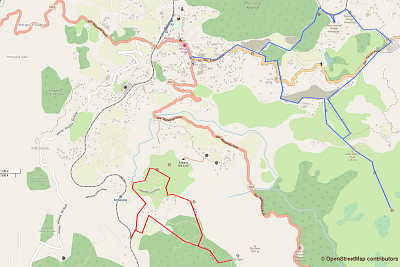 After a few days on the west coast we were happy to move to the Hill Country where we had decided to visit Ella, Haputale and Kandy. We left our guest house in Unawatuna in the early morning and in no time hailed a passing bus on its way to Matara (62 Rs per person). Once in Matara we were told that the bus to Ella would leave at 09:15. It arrived at 09:00 and we quickly secured a seat (250 Rs per person), a good move as it got really full and many people were standing when we eventually left at 09:50. So much for the timetable!
After a few days on the west coast we were happy to move to the Hill Country where we had decided to visit Ella, Haputale and Kandy. We left our guest house in Unawatuna in the early morning and in no time hailed a passing bus on its way to Matara (62 Rs per person). Once in Matara we were told that the bus to Ella would leave at 09:15. It arrived at 09:00 and we quickly secured a seat (250 Rs per person), a good move as it got really full and many people were standing when we eventually left at 09:50. So much for the timetable!
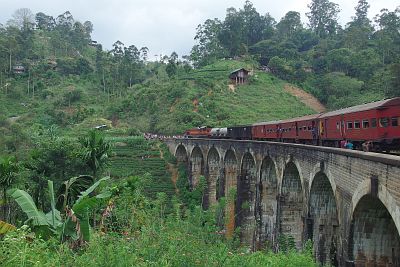 We arrived in Ella at 15:00, quickly found a guest house (Silent Night Home Stay - 2000 Rs with attached bath) and went for a stroll to get our bearings. We did not like very much what we saw: one guest house, café or restaurant after the other, it all felt quite artificial with many tourists around and no apparent village life.
We arrived in Ella at 15:00, quickly found a guest house (Silent Night Home Stay - 2000 Rs with attached bath) and went for a stroll to get our bearings. We did not like very much what we saw: one guest house, café or restaurant after the other, it all felt quite artificial with many tourists around and no apparent village life.
On our first full day we combined the two obvious hikes from Ella, going first to Little Adam's Peak and from there to the famous nine-arched bridge on the railway line, returning to Ella by cutting through the forest. It was a nice day with good though cloudy views. We saw our first tea plantations and spent a lot of time at the bridge relaxing and waiting for a train to go over the bridge.
On our second day we hiked to the top of Ella Rock. We followed the railway track until a point after the station of Kithalella (see map above), passing some rice fields and tea plantations as we made our way up the hill. The last stretch through the forest was a bit steep but the view was well worth the effort: although the clouds were quite low, we could see over to Little Adam's Peak and Ella. We had a long break soaking in the scenery but we could see the clouds thickening and decided to decamp earlier as expected. This did not help and we could not escape the rain which started to fall when we reached the railway line, still quite a way from Ella.
We were hoping for a lull, it was still early in the afternoon and we wanted to return to the nine-arch bridge by following the railway tracks. But we had no luck: the rain got so strong that we had to give up the idea and instead idled the time away in grey and rainy Ella, something which we found quite frustrating.
The next morning we took the train to Haputale, a one-hour pleasant ride as we were lucky to find seats and could enjoy the scenery (3rd class unreserved 25 Rs per person).
There were many touts waiting at the station when we arrived and we followed one of them to his guest house, Great View Holiday, where we took a room with attached bathroom and balcony for 1300 Rs. We were quite pleased with our choice, maybe a bit basic but the view (clouds permitting) from the balcony down the valley was nice (and the shower hot!).
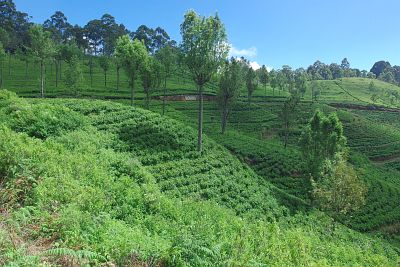 We really loved Haputale: for once the place felt like a real small town with shops, local eateries, a market and people going about their business. There are many guest houses but they are scattered all around and one does not get the feeling of a tourist ghetto the way it is in Ella. The hill slopes were already shrouded with mist when we arrived and we spent the afternoon going to the Adisham Benedictine Monastery, returning to Haputale via Gladstone Road: a pleasant walk with views over tea plantations until it started to rain… Fortunately we had some ponchos but we had to walk the last two and a half kilometers under a heavy rain, water flowing down the road and soaking our shoes. A good thing that it was warm!
We really loved Haputale: for once the place felt like a real small town with shops, local eateries, a market and people going about their business. There are many guest houses but they are scattered all around and one does not get the feeling of a tourist ghetto the way it is in Ella. The hill slopes were already shrouded with mist when we arrived and we spent the afternoon going to the Adisham Benedictine Monastery, returning to Haputale via Gladstone Road: a pleasant walk with views over tea plantations until it started to rain… Fortunately we had some ponchos but we had to walk the last two and a half kilometers under a heavy rain, water flowing down the road and soaking our shoes. A good thing that it was warm!
The sun was shining on our second day and we decided to simply walk along the railway line as long as we enjoyed it. We made it to Idalgashinna train station, came back the same way, approximately 25 km in total. We had good views, went through eucalyptus forests, the Glenanore and Beauvais Estate tea plantations and had to go through a few tunnels, many of them inhabited by bats. We had many opportunities to survey the state of the railway tracks and found many screws and bolts lying along the rails. Some tracks were heavily worn out and many wooden railway sleepers were rotten. It is a good thing that the trains are not driving fast!
We met a team of two men doing an inspection round: one of them had a hammer and a wrench to repair emergency cases while the other noted observations in a book. We did not know whether we should feel reassured by their work or not, it did not seem very efficient.
Our third day in Haputale was the best of all. We took the 7 a.m. bus to the Dambatenne Tea Factory (established by Thomas Lipton in 1890) and walked from there all the way up to the view point called Lipton Seat (approximately 6 km), where Sir Thomas Lipton used to come and enjoy the view over his plantation.
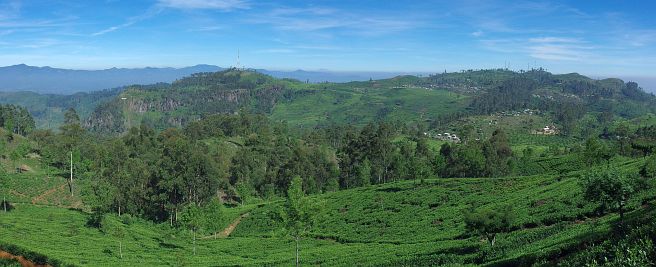 It was a great day, walking through the tea estate, enjoying the scenery, watching the pickers at work. While strolling through the hills, we discovered that the Dambatenne plantation is in fact a closed community with schools, playgrounds, a hospital, a maternity, worker's basic housings, Hindu temples and shops: a sure way to tie the workers to the estate.
It was a great day, walking through the tea estate, enjoying the scenery, watching the pickers at work. While strolling through the hills, we discovered that the Dambatenne plantation is in fact a closed community with schools, playgrounds, a hospital, a maternity, worker's basic housings, Hindu temples and shops: a sure way to tie the workers to the estate.
The majority of Sri Lanka's tea workers are the descendants of Tamils brought by the British from Southern India to work their plantations in the 19th century. They make up about 5% of the country's population, a sizable minority in an otherwise Buddhist society. Citizenship was only granted in 2003 to all stateless persons of Indian origin in Sri Lanka, and things are slow to change. The Tamil workers are still struggling to exercise their citizen rights and to access the state health care and education: linguistic, cultural and geographic barriers make it difficult for them to escape the grip tea companies exercise on their everyday life, binding them to the estate where they work.
This article from BBC dated April 2018 provides a good overview of the working conditions of the country's tea workers. We had the feeling wandering around, that Dambatenne was not the worst of all estates to work on, but what do we know?
There was quite a bit of traffic on the roads crisscrossing the estate: school buses, employee shuttles bringing workers to the field they had been assigned to, lorries transporting the tea leaves from the picking locations to the weigh stations and further to the factory and tuk-tuks transporting locals throughout the estate as well as tourists to Lipton Seat. Once back at the factory, since we had time on our hands we decided to walk all the way down to Haputale (approximately 11 km): with hardly any traffic and the road going down it was a pleasant ending of the day.
While researching for this blog entry I discovered this interesting website telling the history of Ceylon tea with lists of estates, photos, videos and most interesting a timeline showing the development of the Ceylon tea industry against local and international milestones.
And because pictures are sometimes better than words, we have prepared a photo gallery dedicated to the Lipton tea plantation.
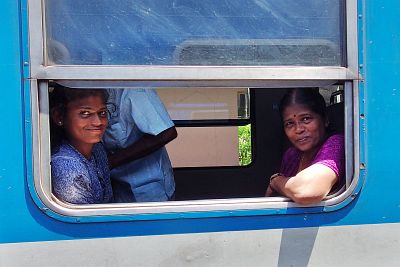 Our next stop in the Hill Country was Kandy. Our train had been quite crowded three days ago when we came to Haputale: many people had joined in Bandarawela and some had to stand in the corridor so we were a bit anxious about the trip to Kandy and wondered whether we should consider reserving two seats. We decided against it in the end: we wanted to travel unreserved and just hoped for the best. And of course, when the train arrived in Haputale it was full. Our car was chock-a-block with school children so we had to stand but it was not too bad as we could stay at the open door and from there enjoy the scenery. We were amazed how much time the train needed between Haputale and Idalgashinna, the part which we had walked two days before: proof that trains are not running very fast in the hill country!
Our next stop in the Hill Country was Kandy. Our train had been quite crowded three days ago when we came to Haputale: many people had joined in Bandarawela and some had to stand in the corridor so we were a bit anxious about the trip to Kandy and wondered whether we should consider reserving two seats. We decided against it in the end: we wanted to travel unreserved and just hoped for the best. And of course, when the train arrived in Haputale it was full. Our car was chock-a-block with school children so we had to stand but it was not too bad as we could stay at the open door and from there enjoy the scenery. We were amazed how much time the train needed between Haputale and Idalgashinna, the part which we had walked two days before: proof that trains are not running very fast in the hill country!
The school kids were good fun: every time we passed a tunnel they started to scream their head off, it was mayhem as would the world come to an end. Nevertheless, we were quite relieved and happy when after one hour they all left at Ambewela Station and we were able to get some window seats. The rest of the ride to Kandy was uneventful, spent admiring the scenery.
You can see some pictures of the scenery we passed on the way to Kandy in our photo gallery dedicated to train travel in Sri Lanka.
Want to read more? Go back to Sri Lankan Snapshot or go on to State of Emergency in Kandy or go up to Blog
$ updated from: Blog.htxt Mon 28 Apr 2025 14:55:28 trvl2 — Copyright © 2025 Vero and Thomas Lauer unless otherwise stated | All rights reserved $




